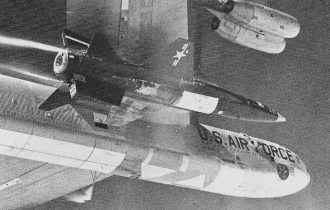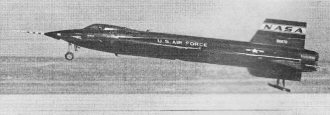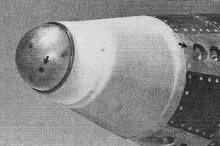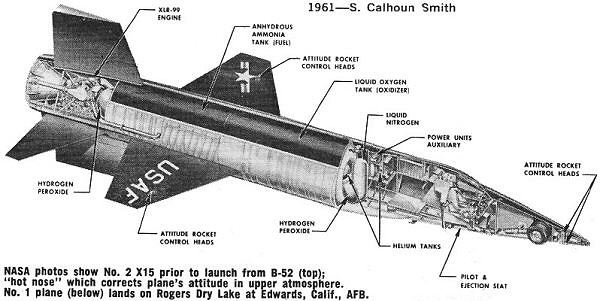|
 The X-15 was an experimental aircraft
developed by NASA and the U.S. Air Force in the 1950s and 1960s. It was a
rocket-powered aircraft designed to explore the high-speed and high-altitude
flight regimes. The X-15 program aimed to gather data on aerodynamics,
structural heat resistance, and control systems for future space and hypersonic
vehicles. The X-15 was primarily built for research purposes, aiming to push the
boundaries of manned flight. It provided valuable data on the effects of high
speeds, altitudes, and temperatures on aircraft and human physiology. The X-15
achieved impressive speeds, with its fastest recorded speed being Mach 6.7
(about 4,520 miles per hour or 7,273 kilometers per hour). It also reached
altitudes of up to 354,200 feet (about 107.96 kilometers). The X-15 was flown by
a select group of experienced test pilots, including Neil Armstrong (the first
person to walk on the Moon), Joe Engle, and Scott Crossfield. From 1959 to 1968,
the X-15 completed a total of 199 flights. These flights were launched from a
B-52 bomber at high altitudes and speeds, after which the X-15's rocket engines
would ignite and propel it further. The X-15 program contributed significantly
to various fields, including aerodynamics, materials science, and spacecraft
design. The data and knowledge gained from the X-15 flights played a crucial
role in the development of the Space Shuttle program and other high-speed
aircraft. The X-15 program paved the way for advancements in space exploration
and the development of future aerospace technologies. It remains an iconic
symbol of NASA's commitment to pushing the boundaries of human flight. The X-15 was an experimental aircraft
developed by NASA and the U.S. Air Force in the 1950s and 1960s. It was a
rocket-powered aircraft designed to explore the high-speed and high-altitude
flight regimes. The X-15 program aimed to gather data on aerodynamics,
structural heat resistance, and control systems for future space and hypersonic
vehicles. The X-15 was primarily built for research purposes, aiming to push the
boundaries of manned flight. It provided valuable data on the effects of high
speeds, altitudes, and temperatures on aircraft and human physiology. The X-15
achieved impressive speeds, with its fastest recorded speed being Mach 6.7
(about 4,520 miles per hour or 7,273 kilometers per hour). It also reached
altitudes of up to 354,200 feet (about 107.96 kilometers). The X-15 was flown by
a select group of experienced test pilots, including Neil Armstrong (the first
person to walk on the Moon), Joe Engle, and Scott Crossfield. From 1959 to 1968,
the X-15 completed a total of 199 flights. These flights were launched from a
B-52 bomber at high altitudes and speeds, after which the X-15's rocket engines
would ignite and propel it further. The X-15 program contributed significantly
to various fields, including aerodynamics, materials science, and spacecraft
design. The data and knowledge gained from the X-15 flights played a crucial
role in the development of the Space Shuttle program and other high-speed
aircraft. The X-15 program paved the way for advancements in space exploration
and the development of future aerospace technologies. It remains an iconic
symbol of NASA's commitment to pushing the boundaries of human flight.
Rocket-Powered X-15 Research Vehicle - Cover Plane
 For the first time in the 34 years that
the Harmon International Aviator's Trophy has been awarded for extraordinary feats
of piloting skill, it went to three pilots instead of the usual single individual. For the first time in the 34 years that
the Harmon International Aviator's Trophy has been awarded for extraordinary feats
of piloting skill, it went to three pilots instead of the usual single individual.
The Harmon award for 1960 was presented to A. Scott Crossfield, NAA; Joseph A.
Walker, NASA, and Maj. Robert A. White, USAF, for their outstanding accomplishments
in flying the rocket-powered X-15 research vehicle.
The mission of the X-15 is to explore flight conditions in space and on the fringe
of the earth's atmosphere. Specifically the X-15 is investigating hypersonic aerodynamics,
characteristics under high aerodynamic heating conditions, effectiveness of reaction-type
controls, piloting problems during exit from and re-entry into the atmosphere.
 The X-I5's (there are three aircraft) are
well on the way to accomplishing these research missions. Maximum speed of 3,603
mph (Mach 5.3) and altitude of 107,700 ft were reached in July 1961. About a year
previously, the X-15 reached the record altitude of 136,500 ft. The X-15 is now
fitted with the Reaction Motors XLR-99 liquid-fueled rocket engine which can deliver
50,000 pounds of thrust. With this engine speeds over Mach 6 (over 4,000 mph) and
altitude up to 100 miles are expected to be reached as the research program continues
through 1961 - S. Calhoun Smith The X-I5's (there are three aircraft) are
well on the way to accomplishing these research missions. Maximum speed of 3,603
mph (Mach 5.3) and altitude of 107,700 ft were reached in July 1961. About a year
previously, the X-15 reached the record altitude of 136,500 ft. The X-15 is now
fitted with the Reaction Motors XLR-99 liquid-fueled rocket engine which can deliver
50,000 pounds of thrust. With this engine speeds over Mach 6 (over 4,000 mph) and
altitude up to 100 miles are expected to be reached as the research program continues
through 1961 - S. Calhoun Smith
NASA photos show No. 2 X15 prior to launch from B-52 (top); "hot nose"
which corrects plane's attitude in upper atmosphere (right). No.1 plane (lower left)
lands on Rogers Dry Lake at Edwards, Calif., AFB.

Cut-Away View of X-15 Rocket Plane
Posted June 10, 2023
|